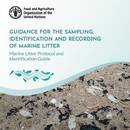EAF-Nansen Programme Communication material

Marine litter, especially marine plastic litter, is becoming more abundant in the ocean, and is having an increasing impact on human health, livelihoods and the environment. To reduce the amount of litter entering the ocean, and reduce the social, economic and environmental impact, society will need to adopt measures to reduce the generation of waste and improve waste management. Providing evidence of the distribution and abundance of marine litter, the location of litter ‘hotspots’, and the proportion of the various categories of litter, will help in the design and implementation of management measures to reduce the leakage of litter to the ocean.These guidelines have been developed for use by researchers in EAF-Nansen Programme Partner Countries to assist them in sampling, identifying and recording marine litter, to a consistent standard.

Urgent action is needed to reduce the leakage of plastics to the ocean. To do this we need more information on the quantities and types of litter that have leaked, especially from regions and countries where data are scarce or lacking. With more knowledge, we will also be able to estimate the risk to local fishing communities in terms of social health well-being and economic resilience. In addition, we will be better placed to assess the impact of litter on key maritime sectors, such as fisheries, as well as on key environmental indicators such as breeding grounds and sensitive habits.
The EAF-Nansen Programme has been running two studies on marine litter. The first study involved the recording of the litter retrieved in the demersal trawl, during surveys with the research vessel (R/V) Dr. Fridtjof Nansen, in the period 2011–2023. The second study examined the impact of marine litter on the beach seine fishery of four countries in the Gulf of Guinea.
The EAF-Nansen Programme is a longstanding partnership between the Food and Agriculture Organization of the United Nations (FAO) and Norway, dating back to 1975. It is executed by FAO in close collaboration with the Institute of Marine Research in Norway (IMR), and funded by the Norwegian Agency for Development Cooperation (Norad).

The second evaluation of the small and medium pelagic fishery in the United Republic of Tanzania was carried out in November 2021, by a group of multidisciplinary experts, including fisheries managers, scientists and fishers. The first evaluation was carried out almost two years after the first benchmark scoring of the fishery, conducted in January 2020, shortly after the start of the project to support the implementation of the small and medium pelagic management plan in the country. The aim was to assess the progress made since the last scoring. The ecosystem approach to fisheries implementation monitoring tool (EAF IMT) was developed to allow the monitoring of the progress of the EAF implementation and sustainable fisheries management. It allows the implementation of the EAF to be evaluated at different levels: at the level of a particular issue, to the level of EAF component, up to the entire fishery level.

La deuxième notation de la pêcherie de la senne de plage pour la mise en œuvre de l'approche écosystémique appliquée à la gestion des pêches (AEP) au Bénin a été réalisée en novembre 2021 par un groupe de gestionnaires des pêches, de scientifiques et de pêcheurs. La première notation avait été réalisée en août 2020, peu après le démarrage du projet d’appui à la mise en œuvre du plan d’aménagement de la senne de plage au Bénin, soutenu par le programme EAF-Nansen. L’outil de suivi de la mise en œuvre de l’AEP, a été développé pour permettre de suivre les progrès de la mise en oeuvre de l’AEP et les réalisations en matière de gestion durable des pêches. Il permet d’évaluer pour une pêcherie, le niveau de mise en œuvre de l’AEP à plusieurs niveaux, à l’échelle d’un enjeu particulier, d’une composante de l’AEP ou sur l’ensemble de la pêcherie.

La deuxième notation de la pêcherie de la senne de plage au Togo a été réalisée en novembre 2021 par un groupe de gestionnaires des pêches, de scientifiques et de pêcheurs représentants de la pêcherie de la senne de plage au Togo. La première notation avait été réalisée en août 2020, peu après le démarrage du projet d’appui à la mise en oeuvre du plan d’aménagement de la senne de plage au Togo, soutenu par le programme EAF-Nansen. L’outil de suivi de la mise en oeuvre de de l'approche écosystémique des pêches (AEP) a été développé pour permettre de suivre les progrès de la mise en oeuvre de l’AEP et les réalisations en matière de gestion durable des pêches. Il permet d’évaluer pour une pêcherie le niveau de mise en oeuvre de l’AEP à plusieurs niveaux, à l’échelle d’un enjeu particulier, d’une composante de l’AEP ou sur l’ensemble de la pêcherie.
